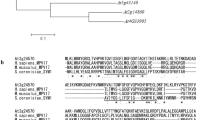Abstract
Previous analysis of the MAP kinase homologue from Pisum sativum (PsMAPK) revealed a potential MAP kinase motif homologous to that found in eukaryotic cdc2 kinases. Sequence comparison showed a 47% identity on amino acid sequence basis to the Saccharomyces cerevisiae Hog 1p MAP kinase involved in the osmoregulatory pathway. Under conditions of salt-stress aberrant morphology of a hog1 deletion mutant was completely restored and growth was partially restored by expression of the PsMAPK. This shows that PsMAPK is functionally active as a MAP kinase in S. cerevisiae. Comparison of PsMAPK with other kinases involved in osmosensitivity, showed a high degree of homology and implicates a possible role for PsMAPK in a P. sativum osmosensing signal transduction pathway.
Similar content being viewed by others
References
Brewster JL, Devaloir T, Dwyer ND, Winter E, Gustin MC: An osmosensing signal transduction pathway in yeast. Science 259: 1760–1763 (1993).
Brewster JL, Gustin M: Positioning of cell growth and division after osmotic stress requires a MAP kinase pathway. Yeast 10: 425–439 (1994).
Fields S, Sternglanz R: The two-hybrid system: an assay for protein-protein interactions. Trends Genet 10: 286–292 (1994).
Galcheva-Gargova Z, Dérijard P, Wu I-H, Davis RJ: An osmosensing signal transduction pathway in mammalian cells. Science 265: 806–808 (1994).
Gietz D, Jean AS, Woods RA, Schiestl RH: Improved method for high efficiency transformation of intact yeast cells. Nucl Acids Res 20: 1425 (1992).
Han J, Lee J-D, Bibs L, Ulevitch RJ: A MAP kinase targeted by endotoxin and hyperosmolarity in mammalian cells. Science 265: 808–811 (1994).
Herskowitz I: MAPK kinase pathways in yeast: for mating and more. Yeast 80: 187–197 (1995).
Jonak C, Heberlebors E, Hirt H: Map kinases: universal multipurpose signaling tools. Plant Mol Biol 24: 407–416 (1994).
Mordret G: Map kinase kinase-a node connecting multiple pathways. Biol Cell 79: 193–207 (1993).
Peter M, Gartner A, Horecka J, Ammerer G, Herskowitz I: FAR1 links the signal transduction pathway to the cell cycle machinery in yeast. Cell 73: 747–760 (1993).
Rose MD, Winston F, Hieter F: Methods in Yeast Genetics: A Laboratory Course Manual. Cold Spring Harbor Laboratory Press, Cold Spring Harbor, NY (1990).
Sambrook J, Fritsch EF, Maniatis T: Molecular cloning: A Laboratory Manual. Cold Spring Harbor Laboratory Press, Cold Spring Harbor, NY (1989).
Schultz J, Ferguson B, Sprague GF: Signal transduction and growth control in yeast. Curr Opin Genet Devel 5: 31–37 (1995).
Stafstrom JP, Altschuler M, Anderson DH: Molecular cloning and expression of a MAP kinase homologue from pea. Plant Mol Biol 22: 83–90 (1993).
Thevelein JM: Signal transduction in yeast. Yeast 10: 1753–1790 (1994).
Author information
Authors and Affiliations
Rights and permissions
About this article
Cite this article
Pöpping, B., Gibbons, T. & Watson, M.D. The Pisum sativum MAP kinase homologue (PsMAPK) rescues the Saccharomyces cerevisiae hog1 deletion mutant under conditions of high osmotic stress. Plant Mol Biol 31, 355–363 (1996). https://doi.org/10.1007/BF00021795
Received:
Accepted:
Issue Date:
DOI: https://doi.org/10.1007/BF00021795




